Do I take the step or not? A friend switched to a standing desk and loved it. The recommendation for you to buy one arrived as swiftly as light from a bulb. You start spending your free time searching the interwebs learning as much as possible about how a desk riser creates a list of benefits helping to avoid bad backs and other maladies.
You step away from your computer screen to watch some TV only to be inundated by the countless VARIDESK® commercials promoting their desktop converters and calling it the best invention since ketchup!
Finally, you decide the time is right to switch from your traditional desk to a sit to stand desk. Thinking an adjustable height desk empties your savings account, you choose a desk riser. You know the riser is cheaper and works right out of the box. You complete the shopping cart on a website, place the order, and wait for the desktop converter to arrive.
Congratulations! You took your first step in the right direction to a healthier choice.
Why Stand at Work?
There are dozens of reasons to stop spending your entire workday sitting in a chair. Over at the Miracle Desk website, they list 46 reasons to stand. In case you do not feel like reading them all, they summarized the top ten in this graphic:
For the sake of argument (and this article), you decide to buy an adjustable height desk to prevent irreversible damage(!) to your body and begin reaping the benefits of standing while at work. You start by clicking "Google Search" and witness the litany of choices in front of you.
At the time I am writing this, my search for "Adjustable Height Desks" resulted in over 22 million results. How do you begin choosing what works best for you?
Eventually, as you browse through the results, you find you have three main categories for adjustable height desks:
- Non-Adjustable desktop kits
- Desktop converters
- Height Adjustable Desks
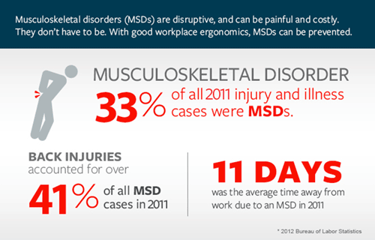
The non-adjustable kits are difficult to switch between sitting and standing. At first blush, the height adjustable desks seem expensive. As a result, desktop converters fall within the Goldilocks zone.
By now, you know what you are looking for, a standing desk converter. Before you decide to buy one, let's break this down to see if a converter is an answer.
What is a Standing Desk Converter/Desk Riser?
A standing desk converter is a smaller desk placed on the top of an existing desk. By squeezing a lever or paddle, you adjust the height of the platform to equal your functioning height.
For example, RightAngle Products features a desktop converter called the Helium Surface.
A multitude of companies manufacturer several designs of desktop converters including:
- X and Z base designs
- Floating
- Electric
- Post with keyboard tray
One main benefit of using a sit stand converter keeps your old desk drawers and not move to a different desk. One situation where a converter works better than a standalone desk is if there is a built-in desk. When considering the cost of removing the original furniture, switching to a desktop converter becomes an easy decision.
Compared to a complete height adjustable desk, a converter is much easier to install, do not weigh as much, and to a certain level, less expensive. Two drawbacks become immediately apparent: limited work surface area and stability.
Although desktop converters get you to stand during your workday, they end up being nothing more than a band-aid solution.
Problems solved. Right? Well, kinda.
When raising a converter up to the height that works for you, take a peek at what moves and what does not. Your keyboard, mouse, and monitor(s) elevate. Your paperwork, phone, and other desk accessories do not. On the surface, this arrangement may not seem significant until that is, you need to staple some paper together while chatting on the phone. To complete this maneuver, expect to walk closer to your traditional desk while, at the same time, balance the phone receiver on your shoulder.
I know, your first thought is 'my Bluetooth® headset eliminates the balancing act.' That is true. However, that headset does not solve the problem of the stapler that is now further away than it was moments ago.
Yeah, But the Desktop Converter is Cheaper. Right?
A perception exists where desktop converters are less expensive than standing desks. By sticking with low- to mid-rated desktop converters, that perception remains true.
Pricing becomes competitive when comparing top-rated desktop converters with less expensive high-quality sit to stand desks. Refer to the table below that compares four desk risers to an adjustable height desk. The price per day equals the list price located on the manufacturer's website divided by 260—the number of weekdays in a year.
[table id=4 /]
At five years, there is only a difference of 22¢ between RightAngle's Bonita adjustable height table and the least expensive desk riser—RightAngle's Helium Surface. Weigh the benefits of having your entire workstation changing at the same height versus the few things a desktop converter moves. Ask yourself: would you pay less than a quarter a day over five years for what an entire height adjustable table brings?
In addition to these benefits, consider these thoughts regarding using a desktop converter.
Desktop Converter Positives
- A desktop riser arrives assembled, you place it on top of your desk
- Up to a certain level of quality, desktop converters are less expensive than a fully adjustable height desk.
- Because installation is a breeze, gaining permission to buy one might be easier.
- Simple installation leads to reduced office disruption—both regarding noise and changing the layout of your office.
- Several varieties of desktop converters include options for multiple monitors.
Desktop Converter Negatives
By far, the most significant disadvantage of a desk riser is that it is not ergonomic! Desktop converters are nothing more than a quick fix: they get you standing, but not in the correct way.
Even sitting in front of a riser is problematic. The average desktop converter raises your keyboard and monitor by an inch, throwing off the ergonomically correct measurement and angle for your eyes while they look at the monitor. To compensate for the additional height, you raise your chair. Now, your feet are not planted firmly on the ground. To solve this issue, you need to get your hands on, well, in this case, your feet, a footrest.
If pressed for a two-word description of a desktop converter, I choose to compensate. According to the Merriam-Webster dictionary, compensating is an intransitive verb meaning to offset an error, defect, or undesired effect.
In my opinion, when working with a desk riser, you continually have to compensate during a typical day. You need to make compensatory moves; whether it is trying to adjust your workstation to become ergonomically correct, answering the phone while setting the converter at a higher position, or just even writing notes on research found in the interwebs. In each of these examples, you need to overcome an undesired effect.
Other negatives of a desk riser include:
- The cost per day for using a desktop converter is comparable to quality, entry-level adjustable height desks. (Refer to the table above.)
- Stability is an issue. Expect to experience bouncing as you type
- Weight capacity becomes an issue. Desktop converters are not able to lift the weight as much as a standing desk
- There is only one. Monitor or keyboard: which one is going to be the correct ergonomic height?
- Physical exertion is involved. People with physical limitations have a more difficult time making adjustments to the converter.
- These limitations are amplified if there are heavy items on the work surface.
- Although desktop converters are lighter than sit to stand desks, they still weigh up to 50 pounds. Portability becomes less of an option.
- A person taller than 6-feet tall has a tough time with proper ergonomic arm positioning. The taller the person is, the more difficult it becomes to keep their arms parallel to the floor.
- The work surface does not have a lot of space for anything other than a mouse, keyboard, or monitor.
- As the X and Z base models reach their maximum height, all items on the desktop become a long-armed reach away
- The long-armed range of X and Z models make a tight cubicle area even smaller. The higher the riser moves, the further away from the desk it goes. If you share a little cubicle or work in a tight space, any extra room you enjoyed behind you disappears.
- Desktop converters are not exactly small. If using a smaller traditional sized desk as your base, expect to lose open free space on the desk
- Cable management becomes difficult, although several manufacturers provide options for solving this dilemma
- Posture—see below
Compromising with Desktop Converters
Posture, or more specifically, ergonomics, is not addressed when using a standing desk converter. In the photos below, we have three people of varying heights sitting and standing behind our Helium Surface.
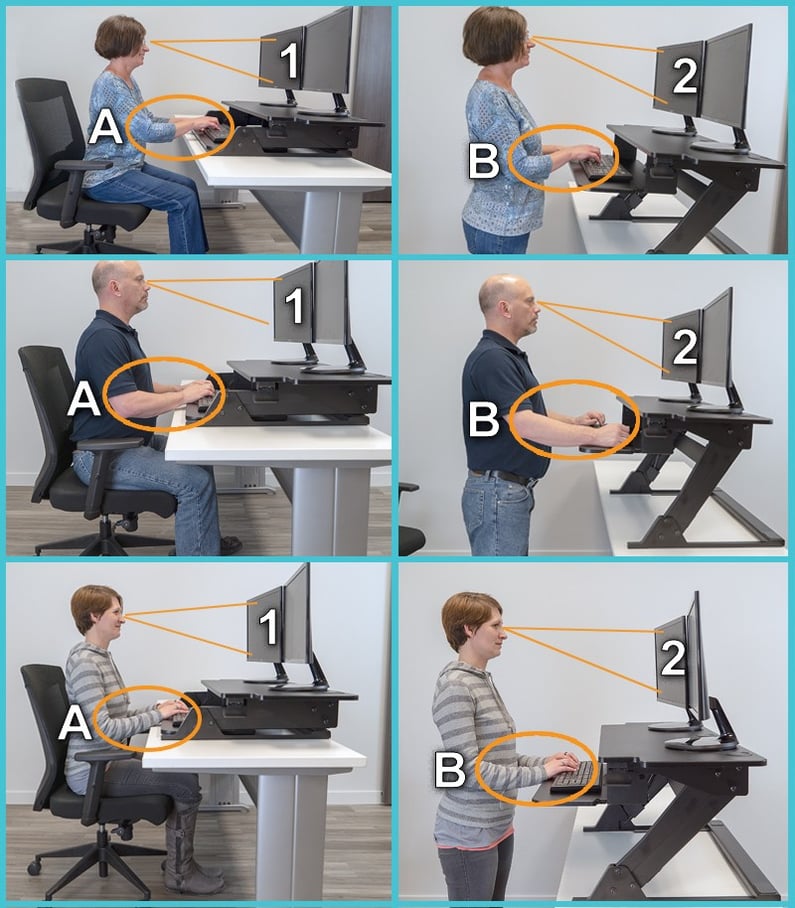
In the first column, we show the relationship between their eyes and the monitors (1). We also circled the positioning of their arms (A). Looking closely, nobody in the first column is successfully implementing the proper ergonomic technique for both the arms and eyes. They have to compromise their posture to make the desktop converter work.
The photos in column two show the same people using the same desktop riser but in a standing position. For different reasons, they still have to make a compromise to their posture to make the converter work.
Note: as the desktop converter moves higher, the distance between the keyboard tray and monitors do not change.
No change means that any necessary compromise while sitting is still needed while standing. Look how the angle of the arms (B) differs between the three people in the photographs, while each person is looking down at the monitors (2). If you adjust the height of the desktop riser, so the position of your eyes is correct, then your arms suffer. Just like before, you have to decide what is more important: the location of your arms or where your eyes rest on the monitors.
Ironically, in a win for us vertically challenged, shorter people have a better chance for proper ergonomics using a desktop converter than tall people. But, as illustrated above, there is still a compromise involved. These problems are amplified if you are over 6-feet tall. Since the monitor height is constant with the work surface, a taller person finds themselves using a severe angle while looking down at them.
Monitor Arms
One solution to the compromise between the monitor and keyboard tray is a monitor arm, such as the Hover Series 2 from RightAngle. A monitor arm does not completely turn the converter into an ergonomic solution, but it is a step in the right direction.
Switch to a Standing Desk
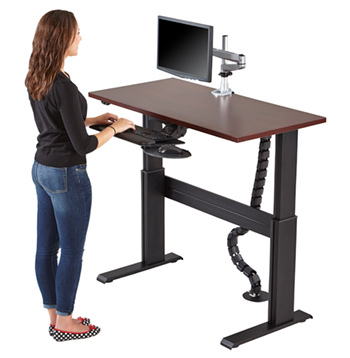
Nearly all the negatives listed for desktop converters disappear when considering a standing desk. The entire work surface adjusts to your preferred height, not just the keyboard, mouse, and monitor. Adjustable height desks are by far more ergonomically successful than a desktop converter kit. Pricing is no longer a stumbling block, either.
Monitor arms solve the issue of compromise between the height of the monitors and the position of your arms. Arms are available in a variety of styles and work with both desktop converters and height adjustable desks.
For years, you would have to spend an arm or leg to afford an adjustable height desk. At first, there were only a few companies that manufactured and sold those desks. It became an easy decision when choosing between a standing desk converter and a sit to stand desk because the converters were the less expensive option. In fact, it was not even close! Converters sold for hundreds of dollars while adjustable height desks sold for thousands.
Times changed. The combination of healthy competition and lower production expenses have brought prices down to the point where the price for a mid-level sit to stand desk is comparable to a standing desk converter. For example, RightAngle's Bonita table evens the playing field when considering adjustable height solutions.
Coming Soon


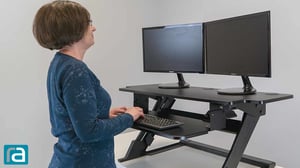
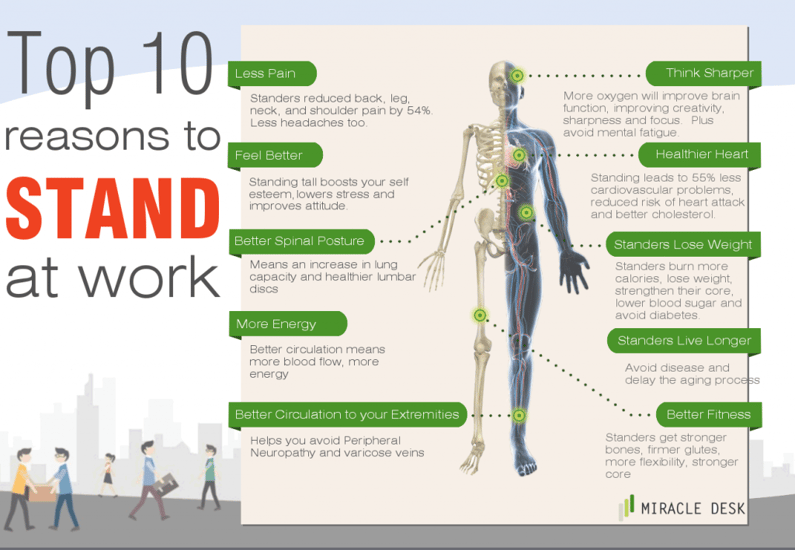

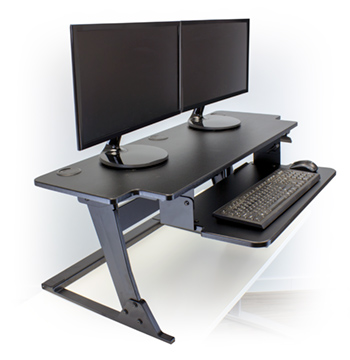

COMMENTS